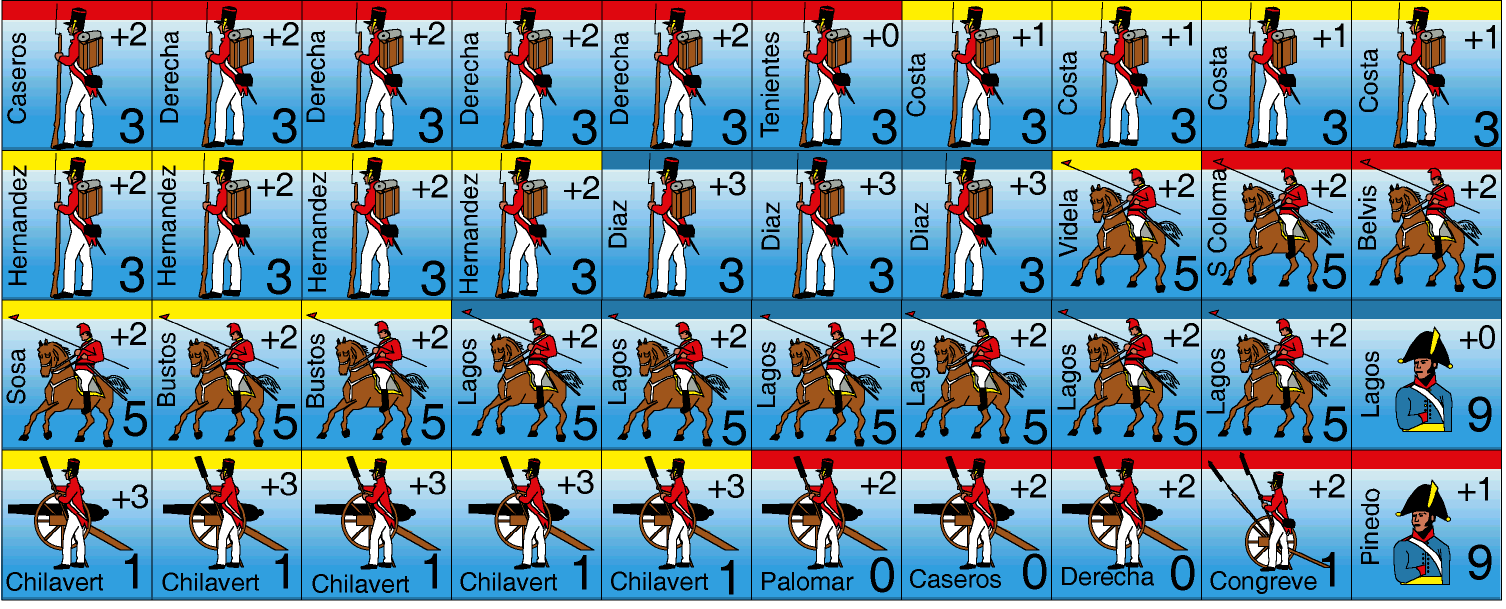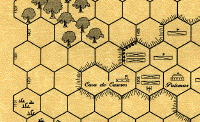|
|
|
|
Caseros 1852 On February 3, 1852 the Battle of Caseros decided the fate of Argentina. The rebel General Urquiza defeated the forces of dictator General Rosas on a grassy plain 10 miles northwest of Buenos Aires, and Argentine democracy was born. Units are regiments and battalions, with 250 meters per hex and 30 minutes to the turn. One 11 by 17 parchment map, 140 color counters, rules and charts. Simple system of leader activation and combat. Rules are included for cavalry charges, cavalry pursuit, off map cavalry movement, wagon barricades, leader poltoonery, and Congreve Rockets. $10.00
|
|

|

|
|
What the reviewers said: "Game components are crisp and professional ..."
"Moorehead has certainly succeeded in his quest. Caseros is a classic design that plays quickly and gives either side a chance to win a big Napoleonic battle." --Doug Murphy in Paper Wars #31 |
|
|
Historical Notes (from the rulesbook) The War
Brigadier General Don Juan Manuel Ortiz de Rosas was not only the Governor and Capitan General of the Province of Buenos Aires, but also the virtual dictator of Argentina. His reign represented the old order, with ties to Spain and the rule of landed and inherited aristocracy. His forces had been primarily on the defensive during the current campaign, and this was the last stand. The field of Caseros was only 10 miles to the northwest of Buenos Aires. Opposing him were the rebel troops of General Justo Josˇ de Urquiza, formerly the Governor of the Province of Entre Rios (which bordered Uruguay). His army also contained contingents from Brazil and the province of Corrientes. Urquiza represented the progressive movement towards Argentine democracy. The Battle of Caseros is considered by many Argentine historians as the final step on Argentina's road to national independence. Urquiza's campaign led him to this point, a final showdown for the capitol. In all, about 50,000 men were assembled on the battlefield, laying claim that this was the largest engagement fought in the Americas prior to the American Civil War. The Infantry Infantry of both sides was fairly similar. The standard formation was the battalion, composed of six companies: a grenadier company, four regular companies, and a light company. The first five companies were usually armed with a Napoleonic smoothbore musket and socket bayonet. The light companies were armed with shorter muskets. None of the muskets had sights, and since these were surplus 40-year old Napoleonic arms, could only be loaded and fired about once a minute. The regulations and tactics were copied from the manuals of both France and Spain. Both sides also styled themselves after the British army of the Napoleonic period, complete with red jackets and black hats (usually also surplus). Thus there was confusion on the battlefield telling friend from foe; Urquiza ordered his men to wear white linen patches on their breasts to identify themselves. The Cavalry The cavalry was organized into regiments, usually with four to five squadrons of two companies each. Some regiments approached division size, while some were only squadron-sized. The practice was to call a formation a "division" whether it approached that size or not; most were named after the commander of the moment. The cavalry regulations were copied from those of both Spain and France, and included dragoons and hussars. Dragoons were usually armed with muskets and sabers, and could fight mounted or dismounted. But most of the cavalry consisted of troops trained to fight mounted and charging; lances were the dominant weapon, usually eight to ten feet long. In fact, the terms "lancer" and "cavalryman" were usually synonymous during this period. Many of the cavalry were from the Pampas grassland regions, and were quite skilled on horseback. They also armed themselves with boleadoras, or "the Three Marias," a set of three lead balls connected with rawhide strips that were thrown. Add to these the usual assortment of knives, swords, and pistols (and the poor rate of fire among the infantry), and cavalry was definitely the dominant arm. The Artillery A battery usually consisted of four to six guns. The guns were normally smoothbore muzzle-loaders that fired a four, six, or eight inch solid shot. Canister was available for close-in defense. The gunners also armed themselves with muskets, pistols, and swords. Horses were used to haul the guns under normal circumstances, but oxen were also used due to the nature of the local roads. While not particularly mobile, the artillery could usually take care of itself. Each side had a unit that was armed with Congreve Rockets (another purchase from the British). While not very accurate, these could cause instant disorganization if they landed close to an infantry or cavalry formation. The Battlefield On the night of February 2, Rosas called a council of war. His very capable, but untrustworthy, General Chilavert had scouted the enemy positions. Chilavert urged Rosas to abandon the area and to move north and west, across Urquiza's lines of supply and communication. Rosas rejected this advice, and decided to give battle. He formed his men up to the east of the Moron creek (just off the western map edge), along a line running east-west and anchored by the Casas de Caseros and the Palomar. The Casa de Caseros (House of Caseros) was a solid brick building with a flat roof and parapets, grilled iron work on the windows, and a turret. Rosas packed about 300 men into the Casa, and constructed a ditch and artillery emplacements in front. Just to the north he had the men erect a wagon barricade, with a large ditch in front. The Palomar (pigeon loft) was a circular three-story building that resembled a Babylonian temple, and was also protected by a thorn hedge and a ditch. Infantry were placed along the hedge, and packed into the three stories of the Palomar, where they could fire down from the windows. Urquiza's army crossed over the Moron creek early in the pre-dawn hours of February 3. Rosas had neglected to destroy the one remaining bridge, and Urquiza quickly formed up the lines for battle. Rosas opened the battle at 8:00 AM, with the artillery in the center firing at long range. The Battle Rosas appeared intent to let Urquiza do the attacking. Urquiza obliged, and opened with a monstrous cavalry charge on his right (eastern) flank. The charge was so furious that General LaMadrid's cavalry completely missed the enemy, and could only regain control of his horsemen five miles later. They never did make it back in time to participate in the battle. Urquiza forgot that he was in overall command, and returned to his roots as a cavalryman, leading the charge. The force of Rosas' cavalry on this flank, under General Lagos, was routed after a stiff fight, and pursued off the field by Urquiza. Rosas tried to salvage the situation by sending Sosa's and Bustos' cavalry to the flank, but these were driven off by General Medina's cavalry, arriving as a second echelon behind Urquiza. Now that Urquiza had blown open the flank, he needed to exploit it. But Urquiza was off pursuing the enemy cavalry. The plan was now for the center of the line, the infantry, to advance, but only the Uruguayans got the orders. They became bogged down in the swampy ground in front of the Casa de Caseros. The attack seemed to be going nowhere. At this point, Colonel Indalecio Chenault, an aide to General Urquiza, acted on his own initiative. He ordered the Brazilian Division to advance, and later for the entire line to attack. As Urquiza's army surged forward, several of the enemy formations broke. Both Costa's and Hernandez's infantry collapsed. General Hernandez and 11 of his own officers were killed by their own men as they tried to rally them. As the wings gave way, only the center held out for Rosas. Diaz's infantry and Chilavert's guns fought on in the bloodiest fighting of the day. As the artillery began to run out of ammo, Chilavert had his men scavenge for ammo to keep the guns firing. As the guns ran out, the artillery men switched to musket fire and engaged in hand-to-hand combat with the advancing Brazilians and Uruguayans. Chilavert was the only commander to see the battle through for Rosas. Rosas himself had fled once he saw the cavalry flee. He and an aide rode to Buenos Aires, and were on the next ship to England. Urquiza, now back on the field, set up his headquarters in Rosas house at about 3:00 PM as the battle ended. Casualties totaled about 600 KIA for Urquiza and 1400 KIA for Rosas. The victorious Urquiza also took 7000 prisoners, 4000 muskets, and 500 wagons of booty. Urquiza went on to write the Constitution of 1853 (modeled closely on that of the United States) and was elected President of Argentina in 1854; Rosas died in obscurity. Historical notes, counter art, and map art are ©1998 by Randy Moorehead |
|
|
|
|